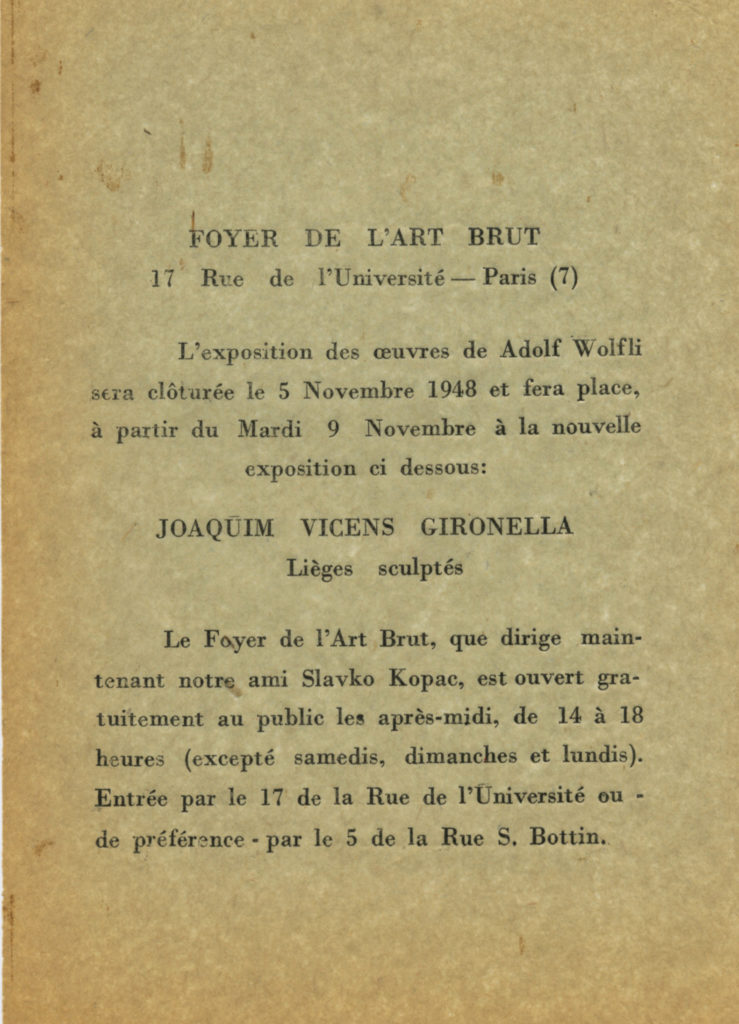
Jean Dubuffet (left) and Slavko Kopac (right)
Jean Dubuffet about Slavko Kopac
Just like my own works, the ones of Kopac turn their backs on institutional art. He denies himself borrowing anything from the cultural intellectualism. He is fully decided on the burning wild spirituality. He is only in pursuit of innocence, of pure invention. His art is, therefore, extremely controlled and refined. It is a very precise barbaric refinement which, starting from the simplest of evocations, the poorest and, by implementing only the most rudimentary means, achieves in its expression an intensity which academic productions no longer know. Kopac and I met when he arrived in Paris, over thirty years ago. His art was already formed then in the way it has remained; his positions, already firmly established, were no longer subject to change. He did not know anything about my paintings, which followed a similar design, just as I knew nothing about his. Our mutual aspirations have brought us together; they started our close friendship. I am very fond of his works; they fill me with a live emotion and admiration.
JEAN DUBUFFET letter from 6. January 1981.
Jean Dubuffet ; Prospectus et tous écrits suivants III, Galimard 1995., p. 267
Compagne de l’Art Brut; Notice – Foyer de l’Art Brut, Paris 1948
Slavko Kopac’s art is truly original, I don’t know of any other resembling it. Across the means of expression so diversely renewed – borrowing all sorts of unexpected materials, depending on the period and, what’s more, using them in a most unexpected way – with a striking consistency, he remained, throughout his evolution, on his very own path, maintaining his unique status. An art, astoundingly inventive, astoundingly poetic. If we try to find a match for it, we shouldn’t look for it in the cultural creations of our time nor in our classical traditions, but in the productions radically strange to the Greek and Latin worlds, like those Scythian or Nordic of the Haute Epoque period that our historians qualify as barbaric. Work which, yet, is not at all barbaric in the deprecatory sense, which Latins assign to this word, but which, quite on the contrary, proceed with an intensified spirituality and an extreme refinement, as equally happens with Kopac’s art. It would, therefore, be utterly wrong to, with regard to it, talk about archaism. On the contrary, it is an instantly trendy art, leaning on scenes our everyday life gives us, with a preference for the most banal objects, most commonly mundane. If ordinary things presently escape our eye, we no longer see them. But Kopac sees them with intensity.
He illuminates them with a bright light. He reveals them to us, in the form of lyrical ideograms powerfully loaded with thought and love. As themes, he likes giving his work very simple topics, we could say very poor. He is undoubtedly smitten with simplicity and with poverty. His joy – which he makes also ours – is to acquire wretched things of impressive luxury, to raise them to a higher level, where all the objects we can see there are equally blown by a high cosmic wind, the high wind which rises from mental conceptions. It is a very serious art. Art of a burning fervour, too, yet contained, reserved, very humble and where no affectation ever interferes. Always rather on an imposing level of a high reverence ritual. After that, dancing with a wonderfully light step, like a Dervish in a trance.
We should now talk about the means – pictorial – which are used in Kopac’s work and which, being a painter myself, I greatly admire. Here, too, he loves starkness. It is in favour of economical use (but very unpredictable and ingenious) that his paintings have such a perturbing effect. His interventions are measured, animated with an appearance we would call botched and with quite a lot of mishaps, apparently caused accidentally. But it is then an accident in which the breath of life is immersed. All of this, yet closely controlled, guided with a precision which fills me with astonishment. No repeats, corrections, all seems to have come from the first attempt, in a rushed, tremendously fortunate improvisation.
It remains to mention his so remarkable social behaviour. His position of total retreat from the professional artistic circles, his contempt for financial benefits and promotions, his stubbornness in living solitarily and reclusively. In this, he joins the authors of the work collected by the Art Brut Collection and which he so wholeheartedly loved.
Jean Dubuffet, the letter of 14th November 1982
Jean Dubuffet (1982.); Prospectus and all subsequent writings, volume III, Gallimard




